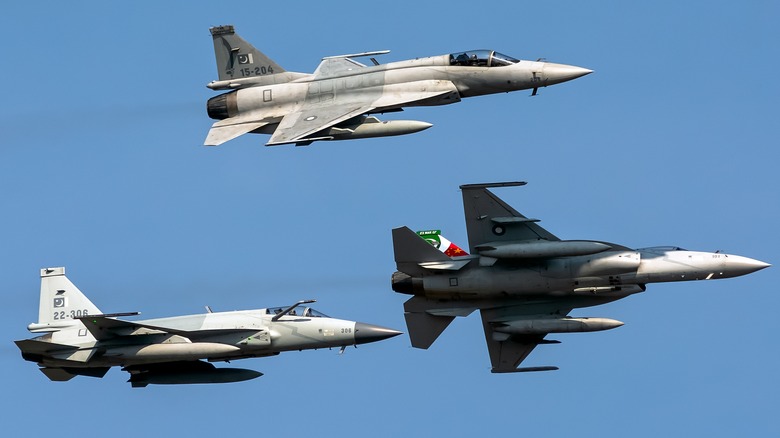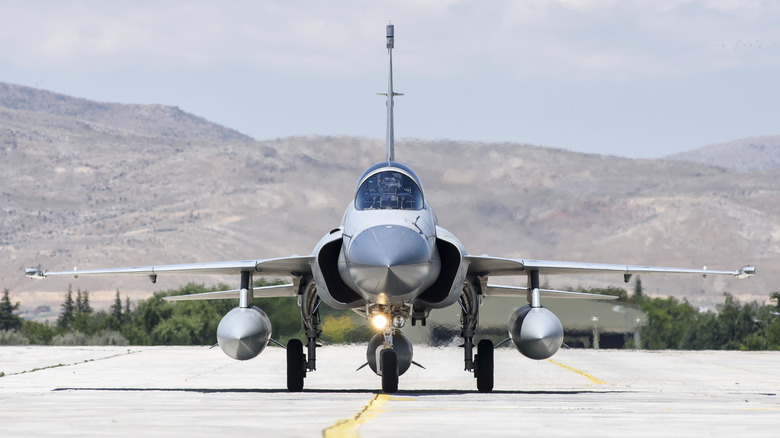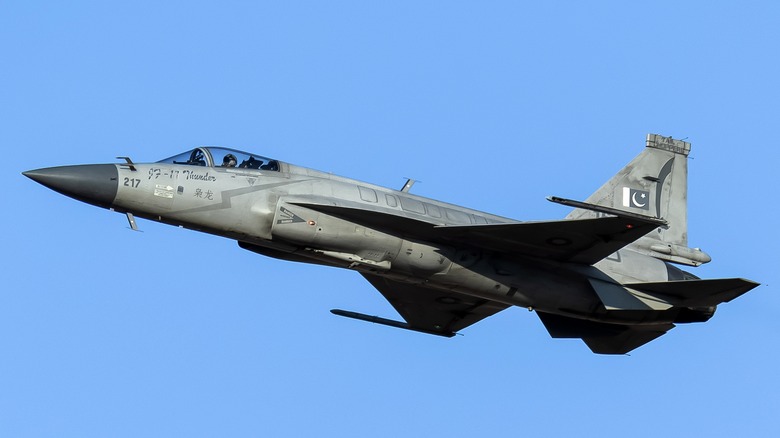Everything To Know About Pakistan's JF-17 Thunder Fighter Jet
Pakistan isn't a country many people think of as having a large air force, and to be fair, it doesn't. The Pakistan Air Force (PAF) is relatively small compared to nations like Russia, China, and the United States, but that doesn't mean it's not flying impressive aircraft. The PAF operates numerous modern aircraft, including American F-16 fighters and French Mirage aircraft. It also flies the JF-17 Thunder fighter jet, which is an intended replacement for the F-16 Fighting Falcon fighter jet.
The JF-17 was co-developed by China's Chengdu Aircraft Corporation (CAC) and the Pakistan Aeronautical Complex (PAC). Despite Chinese involvement in its development, the People's Republic of China doesn't operate the JF-17, though it's not exclusively flown by the PAF. The first prototype came out of the CAC factory on May 31, 2003, and since then, production has increased to around 25 new jets each year. As of September 2024, at least 138 JF-17s have been produced, with another 30 on order.
JF-17s began flying for the PAF in 2007 and have since become the dominant workhorse fighter aircraft operating for Pakistan. Since its introduction, the aircraft has received several updates, resulting in the JF-17 Block III first introduced in December 2023. In addition to Pakistan, three nations also operate the JF-17. World Air Forces 2024's downloadable PDF details which nations operate them and list Myanmar with seven JF-17B and another nine on order. Nigeria flies three, while Azerbaijan has placed an order for eight. Here's everything you need to know about Pakistan's JF-17 Thunder fighter jet.
The JF-17's specifications
The JF-17 is a 4.5-generation fighter, making it comparable to the newest models of the F-15, F-16, MiG-35, Su-30, and the Eurofighter Typhoon. The aircraft is 47 feet long, 15 feet high, and has a relatively tight wingspan of 31 feet. It has a maximum takeoff weight of 29,762 lbs. The JF-17's maximum speed is Mach 1.6 (1,227 mph), and it has a service ceiling of 55,500 feet. The aircraft's G-limit is +8 and -3, and it has a maximum engine thrust of 19,000 lbs. and a thrust-to-weight ratio of 1.07. Additionally, the JF-17 has an operational radius of 842 miles, though it can be refueled in the air.
For armament, the JF-17 boasts eight stations capable of carrying a load of around 7,500 lbs. There is a large variety of different types of ordnance available for the JF-17, including air-to-sea missiles, laser-guided weapon systems, runway penetrating bombs, stand-off weapons, a variety of bombs to use as duds for training purposes, and a 23 mm double barrel gun. Many of the JF-17's munitions are for beyond-visual-range targeting, and they are highly agile and maneuverable vehicles capable of delivering deadly payloads.
In addition to its weapon systems, the JF-17 boasts a variety of electronics and avionics that make it a highly capable modern fighter. Its radar system is highly adept at tracking multiple targets, which it can then prioritize. There's also a built-in jamming protection suite, a smart heads-up display for the pilot, multiple color displays, and a high-tech communications system. The JF-17 is a capable modern fighter that will come to dominate Pakistan's skies. Additionally, future exports could see the JF-17 fly for numerous nations, including Sri Lanka, Egypt, and Malaysia.
The JF-17 is combat-tested
Sometimes, when a nation introduces a fancy new military machine like the JF-17, it can take years before they're ever used in combat. Occasionally, an aircraft or naval vessel like the United States' Ohio-class nuclear missile submarines are rarely, if ever, used in combat, which isn't necessarily a bad thing. Still, when a nation invests tens to hundreds of millions of dollars into a new system, it can feel wasted if it never sees any action. This isn't the case for the JF-17, which has been tried and tested in battlespaces against a variety of enemies, and it's come out on top.
In 2014, Pakistan engaged in Operation Zarb-e-Azb, which targeted terrorists operating along its border with Afghanistan. In 2017, the PAF used a JF-17 to shoot down an Iranian UAV seen operating inside Pakistan's airspace across their shared border. Two years later, JF-17s attacked India in retaliation for attacks, resulting in JF-17s shooting down two Indian fighter jets, marking the first engagement and successful downing of another aircraft in a dogfight.
In January 2025, Pakistan directed its JF-17s to attack Iran in Operation Marg Bar Sarmachar in retaliation for a terrorist attack against Pakistan with ballistic missiles. The strike was incredibly successful, eliminating an enclave of terrorists while causing significant damage to their infrastructure. These incidents all add up to one glaring conclusion: The JF-17 is a highly capable multirole fighter that can stand up against comparable aircraft in a variety of engagements against a multitude of enemies.


